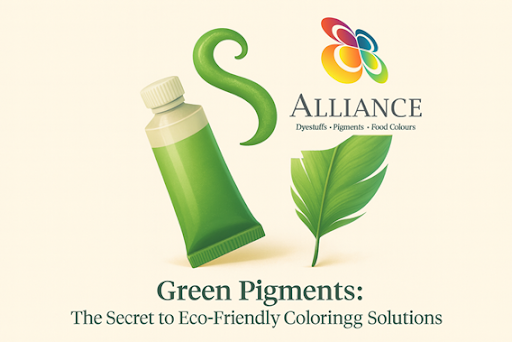Introduction: Color That Cares for the Planet
When you think of “green,” you might imagine lush forests or clean energy. But in the world of industrial colorants, green pigments are taking on a new meaning—one that combines aesthetics with environmental responsibility.
Whether it’s your eco-labeled paint can, the packaging on your organic tea, or even your smartphone case, green pigments are becoming the go-to choice for brands and manufacturers looking to reduce environmental impact without sacrificing performance or visual appeal.
But what exactly are green pigments? And how are they helping industries transition to a more sustainable future?
Let’s dive in.
What Are Green Pigments?
At first glance, “green pigments” might refer to pigments that are green in color—like chromium oxide or phthalocyanine green. But in modern sustainability conversations, the term goes beyond hue. Today, green pigments mean environmentally friendly coloring agents, whether or not they’re actually green.
These pigments are designed or manufactured with:
- Low environmental impact
- Non-toxic ingredients
- Minimal heavy metal content
- Low VOC (volatile organic compound) emissions
- Recyclable or biodegradable carriers
They are safe not only for the environment but also for human health and long-term industrial usage.
Why Green Pigments Are in High Demand
1. Sustainability and Eco-Labeling Pressure
With increasing regulatory pressure and consumer demand for sustainability, companies are now expected to eliminate hazardous substances from their products.
Brands looking for certifications like:
- LEED (for buildings)
- GOTS (for textiles)
- Green Seal (for cleaning products)
- EcoLabel (for packaging)
…are turning to green pigment suppliers to meet color requirements without harming the planet.
2. Health & Safety Benefits
Traditional synthetic pigments—especially those containing lead, cadmium, or chromium VI—pose serious health risks. These toxic compounds can leach into soil and water or pose occupational hazards during production.
Green pigments, on the other hand, are:
- Heavy metal-free
- Skin-safe and allergen-free
- Non-carcinogenic and non-mutagenic
- Safe for use in food-contact applications
This makes them ideal for cosmetics, toys, packaging, and even food-grade plastics.
3. High Performance Across Industries
Eco-friendly doesn’t mean underperforming. Today’s green pigments offer:
- Excellent heat and UV resistance
- High color strength and opacity
- Compatibility with multiple substrates (paper, plastic, textile, metal)
- Long-lasting weather resistance in outdoor applications
Whether it’s paint for building exteriors or masterbatch for plastic injection molding, green pigments now meet industrial standards without compromise.
Applications of Green Pigments in Key Industries
Paints and Coatings
Green pigments are increasingly used in low-VOC paints and natural coatings. They’re ideal for interior wall paints, automotive finishes, and outdoor architectural coatings that meet LEED and GreenPro standards.
Packaging
Brands want packaging that is both vibrant and sustainable. Green pigments are now essential in food-safe inks, recyclable cartons, and compostable film packaging.
Textiles and Fashion
From natural dyed fabrics to synthetic fibers using OEKO-TEX® approved pigments, sustainable coloring is transforming how we dye denim, shirts, and accessories.
Plastics and Consumer Goods
In everything from water bottles to toys to kitchenware, green pigments offer compliance with FDA, RoHS, and REACH regulations—making them safe for widespread consumer use.
Alliance Organics: Your Trusted Green Pigment Partner
At Alliance Organics, we believe that color shouldn’t cost the earth. Our range of eco-friendly green pigments are designed for today’s conscious manufacturers.
We offer:
- High-performance organic and inorganic green pigments
- Azo-free, heavy-metal-free, and VOC-compliant formulations
- REACH, RoHS, GOTS, and FDA certifications
- Custom pigment blends for your unique application
- Technical guidance and documentation for compliance
Our green pigments deliver color you can count on—and a commitment to the planet you can stand behind.
FAQs – People Also Ask
What are green pigments made of?
Modern green pigments are typically made from non-toxic inorganic materials (like chromium oxide green) or organic compounds that are safe and stable, often free of heavy metals and harmful solvents.
Are green pigments only used for color green?
No. “Green pigments” in the eco-friendly context refer to sustainably made pigments of any color—red, yellow, blue, black—that meet environmental safety standards.
Can I use green pigments in food packaging?
Yes. Many food-grade green pigments comply with FDA and EU regulations and are safe for direct or indirect food contact.
Are green pigments more expensive?
Initially, yes. But they provide long-term cost savings by reducing regulatory risks, improving brand reputation, and enabling access to green-certified markets.
Conclusion: Go Green with Color That Lasts
As industries race toward greener operations, pigments are becoming a strategic choice. Choosing sustainable color solutions is no longer optional—it’s a brand differentiator and a regulatory necessity.
Green pigments offer the perfect blend of beauty, durability, and responsibility. And as demand continues to grow, partnering with a forward-thinking supplier like Alliance Organics ensures you stay ahead—visually and ethically.
